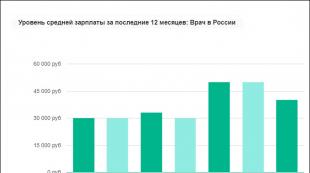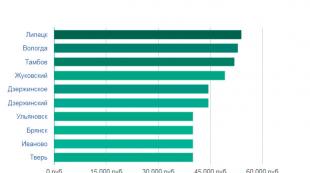Equipment for chocolate production. Own business: chocolate production. Technology and equipment for chocolate production Home-based chocolate business
Chocolate is a sought-after product that is popular all over the world. Both children and adults love him. After all, this is not only a delicacy, but also a healthy product that reduces stress, energizes and stimulates mental activity. A chocolate business is a pleasant investment. It features a significant initial investment and high profitability.
Prospects for the chocolate business
Russians love chocolate: not a single holiday is complete without it, and on weekdays, rarely does anyone refuse to treat themselves to this delicacy. In addition, chocolate is widely used as a gift - from ordinary bars to a set of elite sweets and handmade figurines. Therefore, the demand for chocolate is stable in any economic situation. During holidays, the demand for chocolate increases 3-4 times. Moreover, according to some data, sales increase by 1.5–2 times every year. All these factors make the production and sale of chocolate a promising business area.
The selection of chocolate sweets is huge
Business ideas
There are several options for organizing a chocolate business - from selling ready-made European chocolate to producing unusual chocolate bars.
Chocolate boutique
The simplest option is to open a chocolate shop where ready-made chocolate from foreign and Russian manufacturers will be sold. The simplicity of this business lies in the fact that you do not need to bear the costs of purchasing equipment, renting a workshop, or hiring confectioners and technologists. It is enough to rent a retail outlet in a place with a good flow of potential consumers (for example, in a shopping center or in the business part of the city), and hire several sales consultants. Of course, in this case you will have to invest in the purchase of chocolate (up to 1 million rubles).
The assortment of the chocolate boutique includes thousands of products
Typically, chocolate boutiques target consumers with above-average incomes, and they are in demand for elite chocolate. Among the Russian manufacturers are Korkunov, U Palycha, Konfael, but the brand is, of course, set by European manufacturers (Belgian, Swiss, German, Italian, American). These are world-famous brands Toblerone, Amedei, Wittamer, MoserRoth, Leonidas, Ghirardelli and others.
At the boutique, it is wise to open a small cafe with hot chocolate and various chocolate desserts. The aroma of hot chocolate in the boutique will encourage customers to buy sweets, and you can attract attention with the help of a chocolate fountain. Some cafes add a glass wall to the kitchen so customers can watch how the handmade delicacy is created.
To prepare a hot drink, melt chocolate pieces in milk
Chocolate production line
An automated chocolate production line is expensive equipment, but it allows you to produce large volumes of products and minimize human intervention in the production process. To set up such production, you will need an experienced technologist.
Handmade chocolates and sweets
Handmade chocolate is usually made from ready-made chocolate: it is tempered (melted), then nuts, fruits, spices and other ingredients are added, and then new bars are formed. Such chocolates look very attractive, so they are in demand as an original gift. The same goes for handmade sweets. Belgian chocolate is usually used as a starting material, as it has an amazing taste.
And you can even make chocolate bouquets from sweets.
A bouquet of chocolates looks very unusual
Fruits in chocolate
Fruits in chocolate are an excellent alternative to regular chocolates, in which the words “strawberry” and “cherry” most often mean fudge with added flavors. Citrus fruits and chocolate-covered bananas are a natural delicacy that will delight your loved ones and are suitable as a gift. The disadvantage of such products is their short shelf life. And the main advantage is that you don’t have to bother with making chocolate yourself; you just need to buy high-quality bars without additives and melt them.
Most often, strawberries are covered with chocolate, but there are other options: cherries, tangerine and orange slices, kiwi
Chocolate figures
Chocolate figurines are often used as a romantic gift. They do not have a very long shelf life, and due to the fact that the figurines are usually made by hand, their cost is quite high. Small figures cost 80–200 rubles, and large compositions cost the consumer several thousand rubles. To sell them, you can open your own store or make products to order.
Chocolate hearts are usually chosen as a gift to a beloved girlfriend or wife, children like figurines of animals and cartoon characters, and a man who is a car enthusiast can be given the chocolate car of his dreams. There are also neutral topics. For example, a boss is presented with a horseshoe as a symbol of good luck or a chocolate million dollars. Chocolate paintings and medals are in demand. Corporate clients are in demand for chocolate figurines with a corporate brand, which are usually ordered in large quantities as gifts for clients and business partners, and company employees.
Large chocolate figures are usually made hollow
Chocolate cakes and pastries
Another chocolate product is chocolate cakes. The easiest way is to make them to order. Custom-made cakes with personalized greetings are a popular product that is purchased for birthdays of children and adults, corporate events, New Year's holidays, March 8, anniversaries, weddings, etc.
Chocolate cake with the name of the hero of the day is a great gift
Where to start: business registration
You can organize a chocolatier business in any form convenient for you. If you plan to start with a small amount of investment, register as an individual entrepreneur and choose one of the simplified taxation systems. If you plan to do business with partners, it is better to establish a limited liability company. Are you planning to sell chocolate wholesale to large customers? The LLC format would be preferable.
The registration procedure itself is simple; the tax office registers individual entrepreneurs and LLCs within three days. Provided that you prepare the documents correctly.
Documents for registration of individual entrepreneurs:
- application for state registration of individual entrepreneurs in form P21001 - completed by hand or in printed form;
- a copy of your passport (during a personal visit to the tax office, you must also provide the original so that the inspector can compare the data);
- a copy of the certificate of assignment of an individual tax number (TIN);
- original receipt of payment of state duty (800 rubles).
Documents for LLC registration:
- application in form P11001;
- the decision of the sole founder or the minutes of the general meeting of founders on the creation of an LLC;
- LLC charter (2 copies);
- receipt of payment of state duty (4 thousand rubles);
- documents confirming the presence of a legal address.
If you plan to make chocolate yourself, then choose the following classification codes for economic activities (OKVED):
- 15.84 - Production of cocoa, chocolate and sugar confectionery;
- 52.61 - Retail trade by orders;
- 52.62 - Retail trade in tents and markets;
- 52.63 - Other retail trade outside stores.
Permits
Since the production of chocolate belongs to the food industry, it is necessary to notify Rospotrebnadzor (which now serves as the sanitary and epidemiological station) about the start of activity. Rospotrebnadzor will be able to conduct a scheduled inspection only after three years, and an unscheduled inspection if a complaint is received against you. You must provide the recipe to Rospotrebnadzor to receive a certificate of conformity.
Another authority is the fire inspectorate. It issues a conclusion on the compliance of the working premises with standards (availability of communications, fire protection system, ventilation).
Chocolate production is regulated by the national standard GOST R 52821–2007, adopted in 2010. GOST contains general technical conditions: it determines the composition of various types of chocolate, its taste and smell, consistency, appearance, requirements for raw materials, labeling, packaging, etc.
Selecting a room
If you plan only to produce chocolate without opening a retail outlet, then the location of the workshop does not matter. You can even locate it in the suburbs, as rent is usually cheaper there. When opening a chocolate boutique, it is better to choose a location with high traffic - in the city center or a shopping center. It is best to place the store in a shopping center near gift shops.
This is what an equipped room for chocolate production looks like
As for the requirements for the workshop, they are standard - as for any food production: an area of 40 square meters, good ventilation, heating, hot and cold water. Walls up to a height of 1.5 meters must be tiled, and walls above a level of 1.5 meters must be covered with non-toxic paint.
The premises should be divided into several functional areas: the place of direct production, a warehouse for raw materials and finished products, a rest room for employees, and a toilet. The warehouse for raw materials and products must be at a constant temperature of 16 degrees. After all, if the temperature regime is not observed, the finished chocolate will melt and then harden, which will lead to the formation of an unsightly white coating.
Is it possible to make chocolate at home?
Unfortunately, when running a legal business, food production in an apartment or private house is prohibited. Even if you plan to produce a small volume with your own hands, it is necessary to remove the production premises from the housing stock. But it won’t be possible to do this for premises in a residential building.
Staff
For a chocolate workshop you will need a confectioner-technologist, workers, equipment maintenance personnel, a loader, a driver with a truck, a cleaner, an administrator, a sales manager, an accountant, and a manager. And if there is a store, then there are sales consultants. Of course, at first you can get by with little effort, but you will still need a technologist. You can perform the remaining functions yourself; it is better to outsource some things (for example, accounting, equipment maintenance and transportation services).
In order for chocolate products to be in demand among consumers, care should be taken to hire highly qualified personnel
In addition, the chocolate business often becomes a family business, so feel free to involve your wife (or husband), parents, and adult children. If you do not have experience in the field of chocolate production, it would be useful to take specialized courses (their cost is about 15 thousand rubles).
All employees working directly with chocolate must have health certificates.
Raw materials
You can use ready-made chocolate as a raw material - just melt it, add your ingredients, pour it into molds and cool. But if you plan to make chocolate from scratch, you'll need cocoa powder, cocoa butter, and powdered sugar.
The fruits of the chocolate tree are cocoa beans from which powder and butter are made.
They are inexpensive: cocoa powder - about 120 rubles, cocoa butter - 66 rubles, powdered sugar - 55 rubles per kilogram. GOST allows the addition of carob (carob) fruits to chocolate, which are half the price of cocoa powder - about 60 rubles per kilogram. And cocoa butter can be partially replaced with vegetable (palm) butter - it costs about 50 rubles per kilogram. Milk fat, peanut and coconut oil are also used as a cheaper substitute for cocoa butter. The use of such additives makes it possible to save up to 10% on raw materials.
But it is worth considering that the use of cheaper ingredients affects the taste of chocolate. So if you plan to produce elite chocolate and emphasize its high quality, use the classic recipe.
Chocolate is very diverse. The most popular types: black, milk, bitter, white, aerated chocolate. You can produce chocolate for diabetics, vegans, and those on a diet.
Aerated chocolate is saturated with air bubbles, and white chocolate is made using cocoa butter (without cocoa powder)
The composition of the main types of chocolate is regulated by GOST. Thus, dark chocolate must contain at least 55% cocoa powder and at least 33% cocoa butter, dark chocolate - 40 and 20%, respectively, milk chocolate - at least 25% cocoa products, at least 12% milk solids, at least 2 .5% milk fat.
Alcohol is sometimes used as a flavoring additive. And of course, chocolate with grated, crushed and whole nuts is very popular: hazelnuts, almonds, cashews, peanuts, peeled pistachios, etc. Whole nuts must be roasted and fresh, otherwise a rancid nut will spoil the taste of the entire bar. Pieces of fruit, raisins, waffles, cinnamon, sesame seeds, puffed rice, marmalade and much more are added to chocolate. There are also completely unusual combinations: chocolate with figs, chili peppers, lemon zest, thyme, olives, ginger, dried tomatoes. The fillings for sweets and chocolate bars are also very diverse. In addition to nuts, these are various sweets, soufflés, jelly, nougat. Truffles and pralines are also popular among those with a sweet tooth.
It is important to consider that chocolate usually does not last long - 2–6 months.
Experiment, track which chocolate is in demand, come up with something new and unusual to interest the consumer.
Technological process and equipment
There are fully automated chocolate production lines that allow you to save on hiring employees. But this is expensive equipment. For example, the Russian-made automatic chocolate molding line AC 275 One Shot costs 6.65 million rubles in its basic configuration. An automated line can be operated by 1-2 people, while manual production will require 8-10 people.
Scheme of chocolate production on an automated line
To understand what equipment you need to make chocolate, you need to familiarize yourself with the production technology. It includes several stages:
- Rolling - grinding components in a special mill.
- Conching - thoroughly mixing all ingredients. First, cocoa powder and powdered sugar are mixed, then the liquid evaporates from the mixture, after which the dry mixture is mixed with cocoa butter. As a result, a homogeneous (homogenized) mass is formed. Conching rollers are made of granite, since steel and plastic are not suitable for mixing heated chocolate. Conching directly affects the taste of the chocolate - the longer it is conched, the better. Therefore, elite chocolate is conched for 5–15 days, regular chocolate for 1–3 days.
- Tempering is the cooling (or heating) and crystallization of chocolate at a controlled temperature.
- Molding - filling molds (special molds for chocolate) with the finished mass and hardening.
- Wrapping - packaging chocolate in foil.
If you plan to make handmade chocolates and sweets from ready-made bars, the whole process comes down to three steps: melting the chocolate (tempering), adding filling and molding.
As you can see, the chocolate production technology is quite simple. However, it requires significant investment in equipment. You will need:
- fat boiler for melting cocoa butter;
- a ball mill for rolling, filled with steel balls similar to bearings;
- 3–4 conche machines (melanger) for continuous mixing;
- vertical refrigeration tunnel for cooling molded chocolate or candies.
For small production, conche machines with a capacity of 200 kg are suitable.
Additional equipment includes industrial air conditioning, hoods, thermostats, conveyor belts, heated piping, molds and stamping machine, wrapping machines (capable of wrapping up to 360 tiles per minute), spatulas, scrapers, etc.
To sell chocolate in a store, you will need refrigerated display cases that maintain a temperature of 15–20 degrees.
Table: cost of capital equipment for a chocolate production workshop
Distribution of chocolate products and marketing
The ways to market chocolate depend on what products you will produce and who you will target. If you have a workshop with large production volumes that boasts high-quality products, then you can offer them to other confectionery enterprises that produce desserts, candies and other sweets, as well as cafes and restaurants. If you are focused on end consumers, have developed attractive packaging and a memorable brand, then try to negotiate directly with stores and retail chains. It’s not easy to get on the shelves of large chains, but their turnover is high. You can negotiate with chocolate boutiques, which are found in almost all big cities.
Another option is to open your own store. This may be a point directly next to the workshop, but it is better to focus on shopping centers and city streets with a large flow of pedestrians.
An elite chocolate store can now be found in every major shopping center
Many small businesses, especially those with hand-made production, make chocolate only to order. You can promote it through your own website, social networks, local media, city portals and forums. This method avoids the risk of overproduction and spoilage of unclaimed chocolate.
Of course, at the initial stage you will have to invest in advertising. Use all the methods available to you - from distributing leaflets on the streets (they can be sprinkled with a special perfume with a chocolate scent) to advertising on television. If you are planning to open a chocolate boutique, arrange a grand opening with free tastings. In the future, tastings of new positions can be held once a month.
Franchise or own brand
The main advantage of a franchise is that you will work under an already promoted brand known to consumers. The franchisor will help you organize production and establish distribution channels. However, to become a franchisee (buy a franchise), you need to pay 50 thousand rubles. Some franchises require royalties - monthly payments from profits to the franchisor.
Frade handmade chocolate outlet
Most franchises on the Russian market are offers for the sale of finished products from popular brands. For example, you can become a franchisee of the Belgian company Baccarat, which offers handmade sweets. Of the Russian companies, Frade, a Kazan manufacturer of handmade chocolate, offers a franchise. You can sell Frade chocolate in your city by paying a lump-sum (entry) fee of 50-100 thousand rubles. The Konfael franchise costs from 150 thousand to 12 million rubles, Choconel - from 620 thousand rubles, Candy Shop - from 600 thousand rubles.
Financial plan
Below are the approximate costs of opening a chocolate shop.
Table: initial and ongoing costs for organizing chocolate production
Cost and profitability
Chocolate production is highly profitable - an average of 200%. Judge for yourself: the cost of 1 kg of chocolate is 400–600 rubles, a bar of chocolate in the retail chain (200 grams) is 100–200 rubles. This allows you to receive from 300 thousand to 2 million rubles of profit per month.
Considering the high cost of equipment, the average payback period for chocolate production is from 10 months to 2 years.
Video: how to run a chocolate business
Thus, if you decide to invest in chocolate production, it is better to focus on producing a high-quality product with unusual additives, because it is in constant demand. Although the equipment is quite expensive, the costs will quickly pay off. In this area you can earn up to 2 million rubles per month.
Chocolate has always been and will be in great demand even in difficult times of crisis. Chocolate is the most popular gift for any occasion, be it a “bribe”, gratitude or just a sign of attention.
It's safe to say that chocolate production is a profitable business.
To organize a full-fledged workshop, you will need to spend a significant amount of money on equipment, the purchase of raw materials, and premises for the confectionery shop, so this option is not suitable for everyone.
Business idea - chocolate production, where to start - watch the video:
Some novice businessmen find it difficult to immediately understand all the intricacies of chocolate production, so you can start with.
The most famous companies offering this opportunity are Frade, Chocolate House “vonKluschke”, FrenchKis, COUVERTURE, Chantimel, Confael, BaccaratСhocolatier, Podarilli and others.
The advantages of purchasing a franchise are as follows:
- famous brand;
- tested production techniques;
- well-established technology for sales and display of products;
- good equipment;
- interaction with reliable suppliers;
- providing assistance and advice;
Creating your own lumber production business, features and nuances -.
It is important to remember that this method requires mandatory compliance with company standards.
Another direction will be the opening of a mini-production and boutique of elite chocolate.
The single-product store is a popular format all over the world, and the opportunity to buy chocolate right at the place where it is made looks very tempting for the buyer.
Another worthy business option would be a home workshop for the production of handmade chocolate. This direction is very promising today; you can get truly exclusive and very tasty chocolate.
Recipes for its production can be found on the Internet, and equipment for such production is available to a large circle of people.
Chocolate production technology
The technology for each type of chocolate differs slightly. Whatever type of chocolate production you choose, it will necessarily include the following steps:
- Conching– continuous stirring of the chocolate mass (cocoa mass, powdered sugar, cocoa bean butter, flavorings and additives) until it becomes homogeneous.
Produced in special conches for a long time (up to 5 days). Elite chocolate is conched longer, while regular chocolate usually takes 72 hours. - Molding– giving chocolate the desired shape (bars, candies, bars) and adding filler.
The conched mass is poured into molds at a temperature of 40-45 degrees, then it is cooled to 33 degrees, left for 30-40 minutes while maintaining the temperature (tempering), while stirring.
Next, the molds are cooled and the finished bars or candies are removed from them.
 Technological process of chocolate production. Photo: images.myshared.ru
Technological process of chocolate production. Photo: images.myshared.ru As you can see, the chocolate production technology is not particularly complicated.
Instructions for starting a chocolate production
If you decide to open a production facility yourself, it is recommended that you first attend a chocolatier school, where they provide valuable knowledge about chocolate and the production process.
It is very important to understand that raw materials such as cocoa beans have their own characteristics:
- temperature in the product storage room – 16 C;
- shelf life and sale of goods – from 2 to 6 months;
- availability of special equipment for transporting the product;
- availability of health certificates for staff.
An approximate action plan before opening chocolate production looks like this:
- Registration of an enterprise.
- Obtaining a certificate that gives the right to produce food products from Rospotrebnadzor.
- There you will need to provide a production plan to coordinate sanitary conditions.
- Drawing up a technological map for each type of manufactured product.
- Laboratory testing of raw material samples required to obtain a license for chocolate production.
- Conclusion of an agreement on agreement with periodic inspections.
Organization of the workshop
Equipment cost and business profitability
If we are talking about a large production workshop with expensive equipment, then opening it will require considerable capital.
 Equipment for chocolate production. Photo: idea-small-business.rf
Equipment for chocolate production. Photo: idea-small-business.rf Let's look at the example of a workshop with an area of 100 square meters:
- renting or purchasing premises will cost 20,000-1,000,000 rubles, respectively;
- subsequent repairs cost approximately 400,000 rubles;
- purchase of equipment worth 5.7 million rubles;
- registration of necessary documents - 20,000 rubles;
- advertising costs of 100,000 rubles;
- employee salaries are 180,000 rubles;
- raw materials, provision of building communications - 250,000 rubles.
Special attention should be paid to prices for raw materials and equipment:
- cocoa powder – 120,000 rubles/ton;
- cocoa butter – 66,000 rubles/ton;
- powdered sugar – 55,000 rubles/ton;
- grease boiler – from 300,000 rubles;
- ball mill - from 1.5 million rubles;
- testing machine – from 1 million rubles;
- refrigeration tunnel - from 2.5 million rubles;
- conches - from 400,000 rubles per piece.
Prices for raw materials and equipment depend on the manufacturer and product quality. Moreover, you should also purchase hoods, thermostats, conveyors, and pipelines.
Summarizing, we can conclude that to create a full-fledged chocolate manufacturing workshop, you will need at least 10 million rubles. The figure is scary, but by calculating the ratio of the cost of chocolate to its selling price (profitability), you can see how quickly this production pays off.
Calculation of the cost of 1 kg of dark chocolate
The cost of 1 kg of dark chocolate is approximately 600 rubles. At the same time, a 100 g bar of such chocolate in a store costs at least 100 rubles. Even if we include the company’s expenses in the calculation, we get a minimum profitability of 200%.
And this despite the fact that dark chocolate was created without the use of cost-reducing components.
Experienced manufacturers add components to chocolate that significantly reduce its cost. For example, carob, a grated mixture of carob fruits, costs about 60-70 rubles per 1 kg, when 1 kg of real cocoa powder costs about 600 rubles per kg.
By adding a small amount of carob to chocolate, manufacturers save up to 10% per ton of chocolate.
Basically, such a business pays off in 1.5 – 2 years.
Handmade chocolate price calculation
Now let’s look at this business using the example of a mini-workshop for the production of handmade chocolate in Moscow.
The purchase of the necessary equipment for small production will require a minimum of 150,000 rubles. It is not necessary to purchase a full-fledged production line; you can get by with similar machines designed to produce 5–20 kg of products.
Such equipment can be purchased in specialized stores or on the Internet. Renting premises for mini-production will cost at least 20,000 rubles (depending on location).
It is quite possible to create your own mini-workshop for the production of chocolate, spending 2-3 million rubles. Even taking into account the rental of premises, employee salaries, equipment, taxes, and so on, the profitability of the business is at least 200%.
And with the use of cost-reducing additives, this figure may be higher.
If you have your own mini-production, you can achieve an income of 2,000,000 rubles per month.
Sales market and clients
Business income is directly affected by product sales. Therefore, you need to immediately determine who your buyer will be.
If you have a large production, Establish profitable cooperation with stores to which you plan to supply products.
4 promising ideas for starting your own business in a garage - details.
Bottom line
In order to organize a business in the field of chocolate production, it is not necessary to have outstanding culinary skills.
This is, first of all, a highly profitable and profitable business, but only a company that produces truly high-quality and tasty products can succeed in it.
As you know, there are currently a sufficient number of chocolate manufacturers on the Russian confectionery market (including chocolates, bars, bars, etc.). However, this situation is far from being an obstacle to new manufacturers entering the market.
Moreover, despite the apparent abundance of confectionery (and in particular chocolate) products, the emergence of new manufacturers, especially those producing high-quality and so-called. “premium” brands are strongly encouraged.
Many novice businessmen are reluctant to start a business in food, and even more so confectionery production. Chocolate and other sweets are not considered essential goods, the production of which can quickly turn around the invested capital, and the food and light industries in general are traditionally considered not very profitable.
In addition, many are confused by the need for repeated sanitary and epidemiological inspections of both the products themselves and production premises, because The relevant authorities always pay special attention to food producers.
However, having examined the arguments and counterarguments in some detail, it is not difficult to see that they are untenable.
Chocolate, although formally not an essential commodity, does not lose significant sales volumes even during a crisis. It is one of the favorite products of the population: children love it, like any sweet, and adults, by and large, are just big children in this regard - they very actively consume chocolate, for example, with tea or coffee, instead of a full meal or just for fun.
A box of chocolates is the most common “bribe”, i.e. a thing given in gratitude to minor officials, kindergarten teachers, school teachers and university professors, doctors and/or nurses in the clinic, etc., not to mention chocolates as one of the attributes of a romantic date.
So the fears of a novice entrepreneur regarding finding a sales market and payback are in vain.
As for the increased attention from the authorities monitoring the quality of products and their compliance with sanitary and epidemiological standards, many forget that any production (even not only food production) is still considered by them in this regard.
So attention is paid to everyone without exception: manufacturers, for example, of many building materials (paint and varnish products, any products related to woodworking, etc.) are subject to increased fire safety requirements. You should not be afraid of excessive pickiness of sanitary officials - if everything is really in order with you, no one will do anything to you.
Summarizing all of the above, we can safely say that the production of chocolate and chocolate products is one of the most interesting and profitable areas of business.
Description of technology and specifics of chocolate production
By and large, there is nothing complicated in chocolate production technology. Yes, the raw material - cocoa beans - requires a carefully selected warehouse: a well-ventilated but dry room with an artificially maintained temperature of 16 ° C. But this is where the special requirements for chocolate production are limited. The rest - the workshop, the availability of sanitary books for the staff, etc. meet normal food production requirements.
The main stage of chocolate production is conching. It consists of continuous mixing of the heated chocolate mass until it turns into a homogeneous (homogenized) mass. Conching is carried out in special conches (or, as they are also called, conches).
Pre-mixed chocolate mass (consisting of cocoa mass, powdered sugar, cocoa butter and additives), subjected to rolling - preliminary grinding in special mills.
The main secret of conching is the duration of mixing. It has been found that prolonged stirring significantly improves the quality of the chocolate mass. Therefore, many elite varieties of chocolate undergo conching for 360 hours, or 5 days.
The normal duration of this process is about 72 hours (3 days). For cheaper varieties, one day of conching is enough.
The conching itself is carried out in three stages: first, the dry mixture (cocoa powder and powdered sugar) is mixed, in the second, excess moisture is evaporated from the mixture, and in the third, cocoa butter (or its substitute) is added to the dry mixture.
Of course, the taste and quality of chocolate is influenced by various flavoring and aromatic additives (flavors, alcohol, wine and the like), and also by the percentage of natural ingredients (for example, instead of quite expensive cocoa butter, palm, coconut, peanut, milk fat are often added or they combine these components with each other; instead of cocoa powder, carob or carob powder is sometimes used). But ultimately, the recipe for the resulting chocolate is usually a company secret.
The second most important stage of chocolate production is molding, i.e. giving the chocolate mass the appropriate shape (bars, candies, bars, etc.) and filling (if, of course, it is provided by the manufacturer) with crushed nuts, candied fruits, waffles, etc.
The prepared chocolate mass at a temperature of +40 to +45 ° C is poured into special molds (molds). Then it is quickly cooled to 33°C, and, maintained at this temperature for 30-40 minutes, is constantly stirred. This allows the cocoa butter to crystallize properly. This process is called tempering.
Cost of equipment and profitability of chocolate production
Of course, the list of equipment for chocolate production is not limited to a conche machine and a set of molds. For the normal functioning of a chocolate production line, a lot more different equipment is required.
For example, to melt fat (cocoa butter), a special fat burning boiler is required (costing about a third of a million rubles - for a boiler with a capacity, i.e., a working volume of 200 kg of oil); The primary mixing of components (rolling) is carried out in ball mills filled with special steel balls like bearings, with the help of which the mixing process takes place.
Such a mill costs about one and a half million rubles. It comes with 1 conche, but taking into account the technology - the chocolate mass should be mixed for at least a day - you will have to purchase additional conches (each of which costs about 8000-9000 €) so as not to stop the conveyor.
In addition, you will also need a tempering machine (about 1 million rubles) and a vertical refrigeration tunnel that produces the rapid cooling of molded products required by the technology. Such a tunnel will cost approximately 2.5 million rubles.
This is just the basic technique needed to make chocolate. Additional - hoods and thermostats for finished product warehouses, conveyor belts, aeration units, special planetary pumps and heated pipelines for moving liquid chocolate mass from unit to unit, molds and a stamping machine for their manufacture, packaging and other machines in total will not pull less than 4-5 million rubles.
As you can see, the total costs are not too high - something around 10 million rubles, but quite sensitive for a novice businessman.
But these costs pay off very quickly if we consider in more detail the relationship between the cost of chocolate and its selling price, i.e. calculate profitability.
If we consider regular dark chocolate, without the addition of soy, palm oil and other cheap substitutes (namely, it is the least cost-effective), then it consists of approximately 60% (by weight) of cocoa powder (about $ 1870-2010 for 1 t), and 40% from powdered sugar (about $1000 per 1 ton), we get the cost of 1 ton of chocolate (including a small percentage of cocoa butter) at about $1500-1600, or $15-16 (less than 500 rubles) per 1 kg.
Even if, for simplicity, we consider 1 kg of dark chocolate to be equal in cost to 500 rubles. (with labor costs, taxes, depreciation and other costs), and the price of a bar of such chocolate is equal to 100 rubles, we get a minimum profitability of 200%.
This is the lowest limit. Adding various cost-reducing additives to a chocolate recipe literally increases profitability several times over.
Compare: carob, carob powder costs about 50-67 rubles. for 1 kg versus $18.7-20.1 (565-608 rubles) for real cocoa powder. Adding even 5% carob will help save about 8-10% ($120-160) per ton of chocolate.
Video about chocolate production
The raw material for the production of which is cocoa butter, which is a product of processing cocoa beans - the seeds of the chocolate tree, rich in theobromine and caffeine.
The product has become widespread throughout the world, becoming one of the most popular types of food; its taste is often used in cooking. It is included in a huge number of products, mainly dessert ones, such as puddings, cakes, mousses, cookies and pastries.
It comes in a variety of shapes (such as the heart symbol) and is traditional in some countries during holidays such as Easter and Valentine's Day. It is also used in hot and cold drinks such as chocolate and, of course, hot chocolate.
Types of chocolate
Depending on the composition, the following types are distinguished:
Special composition variations:
- Vegan. Can be either regular dark chocolate without milk, or based on soy, almond, coconut or rice milk.
- Diabetic. Intended for patients with diabetes. Instead of sugar, sweeteners such as sorbitol, xylitol, mannitol or isomalt are used.
Variants of chocolate products
- Porous chocolate is obtained from chocolate mass, which is poured into molds of ¾ volume, placed in vacuum boilers and kept in a liquid state (at a temperature of 40 ° C) for 4 hours. In a vacuum, due to the expansion of air bubbles, a porous tile structure is formed.
- Tiles. They can consist of contrasting white and dark (or milk) chocolate, which allows you to give the bar an original design. Various sweet fillings are often added to chocolate bars.
Chocolate in other confectionery products
- Glazes for coating various confectionery products are usually based on a milky form, which has a dark color.
- Cocoa is often used to impart chocolate flavor and aroma to doughs, fillings, creams, etc. etc.
Powder and liquid chocolate
- Powder type is produced from cocoa mass and powdered sugar without or with the addition of dairy products.
Equipment for chocolate production
For its production and products made from it, the following equipment is used:
- Casting line;
- Tempering machines;
- Conche machines;
- Chocolate Mill;
- Ball mills;
- Mills for grinding sugar;
- Lines for the production of nut butter and cocoa mass;
- Vacuum boilers for the production of porous types;
- Tanks for melting fat, etc.
The complete list depends on the specific product.
Chocolate production technology + video on how to make it
Raw materials and flavoring
The main raw materials for the production of chocolate and cocoa powder are cocoa beans - the seeds of the cocoa tree, which grows in tropical regions of the globe. The names of commercial varieties of cocoa beans correspond to the name of the area of their production, country or port of export (Ghana, Bahia, Cameroon, Trinidad, etc.). Based on quality, cocoa beans are divided into two groups:
- noble (varietal), having a delicate taste and a pleasant subtle aroma with many shades (Java, Trinidad, etc.);
- consumer (ordinary), having a bitter, tart, sour taste and strong aroma (Bahia, Para, etc.).
Cocoa beans are found in the pulp of the fruit of the cocoa tree, 30-50 pieces each, have an almond shape, about 2.5 cm long. The bean consists of a hard core formed by two cotyledons, an embryo (sprout) and a hard shell (cocoa shell).
Freshly picked cocoa beans do not have the taste and aroma properties characteristic of chocolate and cocoa powder; they have a bitter-tart taste and are pale in color. To improve the taste and aroma, they are subjected to fermentation and drying on plantations.
The main components of the dry matter of cocoa beans are fats, alkaloids - theobromine, caffeine (in small quantities), proteins, carbohydrates, tannins and minerals, organic acids, aromatic compounds and more.
Chocolate products often contain aromatic additives such as coffee, alcohol, cognac, vanillin, pepper, as well as food additives in the form of raisins, nuts, waffles, and candied fruits.
Currently, there are a large number of different technologies with which you can create products of the highest quality. But, all the same, many confectioners prefer to use the old “old-fashioned” method.
As you can see, you can use anything in the production of chocolate, the main thing is that it is cocoa products. Of course, unfortunately, cocoa beans do not grow in our country, which is why most often confectionery companies in our country use either ready-made material from cocoa beans, or grind the cocoa beans themselves to a homogeneous mass, namely, into powder.
Process description
Chocolate mass is made from a mixture of sugar (usually powdered sugar), cocoa mass and cocoa butter, with the addition of flavoring and aromatic ingredients. The mixture is crushed using a melanger (solid particles should not be larger than 20 microns), mixed again with cocoa butter, cooled to 30-31 ° C, after which it enters the molding machine.
More detailed video:
Currently, there are a large number of different products that have been able to conquer every person around the world. There is also a large variety of semi-finished products. They, of course, are not as healthy as natural chocolate, but they have a fairly pleasant taste. Such semi-finished products are considered various candies, bars and much more.
Expenses
The list of requirements for production includes maintaining cleanliness and order, having employees have sanitary records, and correct storage conditions for products and products. It turns out that producing high-quality goods even using the simplest recipes is very cost-effective. For example, for 1 kilogram of dark chocolate you will need:
- kilo of cocoa powder - 500 rubles;
- kilo of powdered sugar - 40 rubles;
- cocoa butter - approximately 60 rubles.
Thus, it turns out that the price of 1 kilogram of a product, which contains 70 percent cocoa powder and no artificial additives, is approximately 400 rubles. The retail price of a 200-gram tile starts from 200-250 rubles. Add here the costs of staff, rental premises, depreciation of equipment, taxes, and in any case the figure will be at least 200 percent of net profit.
 You need to start your path into this business with the book “Chocolate” by William Curley, who is a true innovator in this world of sweets. He reveals the secrets of creating delicious and spectacular chocolate products. The reader will become familiar with the truly creative nature of the work of a master chocolatier. Curley begins his story by listing the qualities of chocolate, talking about the variety of its tastes, richness, texture and the unique characteristics of different varieties of cocoa beans. Step-by-step instructions and photographs will help you understand all the most important things - from tempering techniques to preparing the basic ganache.
You need to start your path into this business with the book “Chocolate” by William Curley, who is a true innovator in this world of sweets. He reveals the secrets of creating delicious and spectacular chocolate products. The reader will become familiar with the truly creative nature of the work of a master chocolatier. Curley begins his story by listing the qualities of chocolate, talking about the variety of its tastes, richness, texture and the unique characteristics of different varieties of cocoa beans. Step-by-step instructions and photographs will help you understand all the most important things - from tempering techniques to preparing the basic ganache.
Each section of the book includes a selection of delicacies - from simple classics like dark chocolate truffles, chocolate florentines and “millionaire's shortbread” to more complex confectionery creations like “box” or Paris-Brest cake. Each of the desserts is unique due to not only its exquisite taste, but also its beauty.
If you decide to get an education or decide to hire/train staff.
In addition, a small chocolate business brings great benefits and pays off fairly quickly.
To open a chocolate business, you need to rent the right premises, since cocoa beans, a raw material, are very demanding in terms of living conditions. Therefore, the room for chocolate production must be very well ventilated and always dry - chocolate does not like moisture, and the temperature in this room should be no more than 17 degrees.
Like the production of any other food product, the chocolate business requires the premises to comply with sanitary standards, complete cleanliness and constant fight against dust and dirt.
Equipment for chocolate production
In order to open chocolate production, you need to purchase special equipment. First of all, this is a cauldron in which the fat will melt. Its average cost is from 300 thousand rubles. A ball mill for mixing components will cost more than one and a half million rubles, and a tempering machine will cost at least a million.
In order for production to be continuous, there must be several conches, each costing at least half a million. Cooling the molding will require a special refrigeration tunnel, the cost of which is from two and a half million.
In addition, a large amount of auxiliary equipment will be required: conveyor belts, hoods, thermostats for folding the finished chocolate, as well as pipelines. All additional equipment will cost the entrepreneur an average of 5 million rubles.
Raw materials
The raw materials for chocolate production consist of three main ingredients: powder, cocoa butter and powdered sugar. The most important ingredient - powder - costs from 500 rubles per kilogram, but in some industries it is replaced with carob powder - carob, since it costs only 60 rubles per kilogram.
At the same time, the quality of chocolate deteriorates accordingly. And cocoa butter can be replaced with milk fat or palm oil.
Sales









